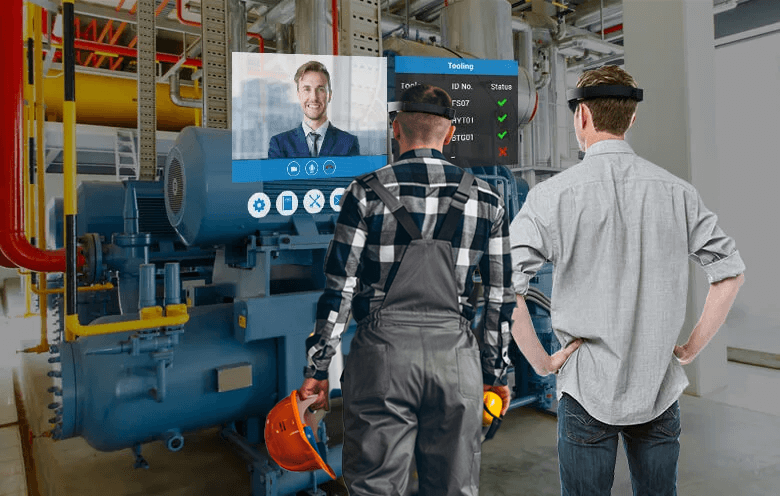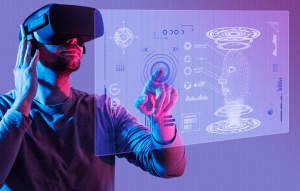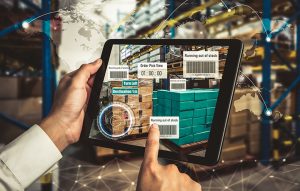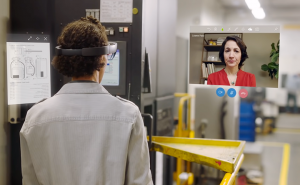In highly operation-driven industries like manufacturing and oil & gas, staying competitive needs a workforce equipped with the latest skills. Traditional training methods often fall short in engaging employees and creating immersive learning experiences. Here is where augmented reality (AR) training comes into play. AR-powered training merges digital information and simulations with the real world, which is more engaging and effective. It is better than traditional training because it improves procedural knowledge acquisition and retention.
In this blog, we will explore augmented reality (AR) training. We will discuss its benefits, real-world success stories, potential challenges, and how it can revolutionize your organization’s employee development strategies.
What is AR training and how does it work?
AR training takes learning to a whole new level. It goes beyond static presentations and passive learning by immersing you in an interactive and engaging experience. By overlaying digital information, simulations and instructional content onto real-world environments, this AR-based training solution makes learning more exciting and impactful.
Equipped with sensors and cameras, AR devices offer real-time feedback, guidance, and interactive exercises that elevate your learning and boost knowledge retention. Whether you are simulating complex machinery operations or receiving step-by-step instructions for hazardous tasks, augmented reality employee training revolutionizes your workforce development.
What are the benefits of using augmented reality in employee training
- Exponential engagement and lasting retention: AR training allows you to interact with lifelike virtual scenarios and simulations. It creates highly engaging and memorable learning experiences. Active participation leads to heightened engagement and long-term retention of knowledge.
- Streamlined efficiency: You can facilitate your trainees with augmented reality to offer them on-demand access to training materials and guidance. Implement augmented reality for employee training to enable them to learn at their own pace, reduce training time and costs while ensuring top-quality instruction.
- Empowering safety in high-risk environments: In high-risk environments, AR training becomes a game-changer for safety. AR provides controlled environments for employees to practice how to handle hazardous situations. It enhances safety protocols, minimizes the risk of accidents and boosts employee confidence in performing critical tasks.
- Improved safety: You can use augmented reality in safety training to fortify protection by providing workers with real-time information and instructions in hazardous environments. This can help to reduce the risk of accidents and injuries.
- Increased efficiency: AR training can help you to increase efficiency by reducing the time and cost of training. Your employees can learn new skills and gain knowledge more quickly and easily, while being productive on the job.
- Enhanced learning: AR training can help to enhance learning by making it more interactive and engaging. Your trainees can learn by doing and they can see how the information they are learning applies to the real-world scenarios.
- Improved compliance: You can improve compliance by providing training on it using augmented reality. Educate your employees with the information they need to for adhering safety regulations and procedures. This can help you to protect the company from liability and fines.
Overall, AR training is a powerful tool that can help your organization improve safety, efficiency and learning outcomes. If you are looking for a way to revolutionize your training program, AR training is a great option to consider.
Some use cases for augmented reality training
- Operating new machinery or equipment: You can experience the transformative power of augmented reality in manufacturing training by overlaying digital instructions onto the real-world equipment. This can help your workforce learn how to operate new machinery or equipment quicker and safer. AR training gives instructions in trainees’ field of view and teaches how to interact with the equipment in real time.
- Troubleshooting problems: Empower your problem-solving skills with AR training. With AR as your guide, you can equip your employees with cues necessary to efficiently troubleshoot problems with machinery or equipment. With overlaying digital diagrams and instructions onto the real-world equipment, your employees can find the problem and fix it quickly.
- Working safely in the factory: Maximize safety in your factory with augmented reality training. Overlaying digital safety instructions and hazard alerts onto the real-world environment, AR empowers you to work securely and avoid accidents. Prioritize your well-being by embracing AR training and revolutionize safety practices in your factory.
- Inspecting products: Elevate your quality control practices with AR training. By overlaying digital inspection checklists and instructions onto the real-world product, AR empowers you identify defects quickly and accurately. Enhance your inspection capabilities and ensure superior product quality with AR training.
- Maintaining equipment: Maximize your equipment’s lifespan and performance with AR training. AR training gives instant access to step-by-step guidance and visual aids, allowing you to perform maintenance tasks accurately and efficiently.
- Inspecting pipelines: With AR training, you can inspect pipelines effectively by overlaying digital diagrams and instructions onto the real-world pipeline. This can help your employees to identify potential problems with the pipeline and to fix them before they cause an accident.
- Operating drilling equipment: Streamline your equipment operation and enhance your skill with AR training. By overlaying digital instructions and diagrams onto the real-world equipment, AR empowers you to learn and operate with enhanced safety and efficiency.
- Responding to emergencies: AR training equips you with the skills to effectively respond to emergencies. By overlaying digital emergency procedures onto the real-world environment, AR empowers you to take the right actions swiftly and confidently during critical situations. Prioritize safety and be prepared with AR training for emergency response.
- Exploring oil and gas fields: Train your employees how to explore oil and gas fields by overlaying digital maps and data onto the real-world environment using AR. This can help them to find new oil and gas deposits more quickly and efficiently.
- Maintaining oil and gas facilities: AR training can teach your employees how to maintain oil and gas facilities. With an overlay of digital maintenance instructions and diagrams onto the real-world facility, AR ensures that you can keep your facility in optimal working order.
Suggested: Ignoring Augmented Reality for Telecom Training & Maintenance is a Costly Mistake! Know how.
Real-life examples of augmented reality training in manufacturing and energy industries
Leading companies across various industries have recognized the immense potential of augmented reality (AR) training to propel their workforce’s skills and capabilities.
Let’s explore: Why the automotive industry must not overlook the Augmented Reality Training Revolution
Bosch: Bosch is using AR training to teach employees how to repair and maintain machinery in its manufacturing plants. The AR training allows employees to see step-by-step instructions and diagrams overlaid on the real-world machinery, which helps them to learn more quickly and accurately.
DHL: DHL uses AR to train its warehouse employees on how to pick and pack orders. The AR training provides employees with real-time information about the location of products in the warehouse, which helps them to pick orders more quickly and efficiently.
Caterpillar: Caterpillar is using AR to train its employees on how to repair and maintain its heavy equipment. The AR training allows employees to see step-by-step instructions and diagrams overlaid on the equipment, which helps them to learn more quickly and accurately.
General Electric: GE uses AR to train its employees on how to operate and maintain its oil and gas equipment. The AR training provides employees with 3D models of the equipment, as well as step-by-step instructions and troubleshooting tips.
Challenges and considerations of implementing AR training
1. Cost: Implementing AR training for driving value in your industrial enterprise may involve higher costs due to specialized hardware and custom content development.
- Start with pilot projects: Test augmented reality employee training on a smaller scale to evaluate its effectiveness and cost-efficiency.
- Collaborate with AR solution providers: Partnering with experts in augmented reality corporate training can help optimize costs while leveraging their expertise.
- Gradual scaling: Gradually expand your augmented reality training initiatives ensures careful evaluation of costs at each stage.
2. Hardware requirements: Augmented reality manufacturing training and other applications require specific devices, which can pose implementation challenges.
- Provide necessary hardware: Equip your employees with the required headsets and tablets, ensuring they have access to augmented reality training resources.
- Cloud-based solutions: Explore cloud-based AR training options that eliminate the need for individual hardware, making it more accessible for your workforce.
3. Accessibility consideration: While AR training offers immersive experiences, it may not be accessible to all employees, such as those with visual impairments.
- AR-based solutions for inclusivity: Look for augmented reality training platforms that are accessible to people with visual impairments, using alternative sensory cues and interfaces.
- Alternative training methods: Ensure equal learning opportunities for all employees by offering supplementary training methods alongside augmented reality safety training and other applications.
Leverage augmented reality training for workforce excellence
The emergence of augmented reality training has brought a revolution to the manufacturing and oil & gas industries. By integrating AR into training programs, organizations can unlock unparalleled engagement, retention and efficiency. While challenges may arise, the tremendous benefits make AR training an investment worth pursuing. If you want to adopt augmented reality for employee training, then talk to our experts to bridge the gap between knowledge and application.









